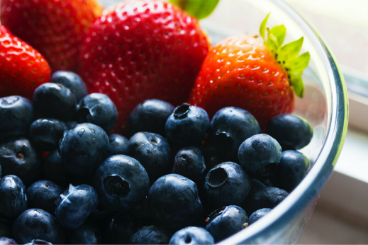Keeping Fruits and Vegetables Fresher for Longer with MAP
Innovation
April 14, 2020Reading time: 2 minutes
When it comes to fruits and vegetables, maintaining freshness, preserving nutritional values, and increasing shelf life are all vitally important for producers and retailers. This is especially true of highly perishable produce. Such foods demand a technical approach to packaging, one in which the atmosphere within the packaging itself slows respiration and extends shelf life.
When it comes to fruits and vegetables, maintaining freshness, preserving nutritional values, and increasing shelf life are all vitally important for producers and retailers. This is especially true of highly perishable produce. Such foods demand a technical approach to packaging, one in which the atmosphere within the packaging itself slows respiration and extends shelf life.

What is Modified Atmosphere Packaging?
Modified Atmosphere Packaging, or MAP, is the process of tailoring the gases within a package’s internal atmosphere. MAP can aid with reducing food waste, as well as supporting seasonal extensions, and ensuring consistently high levels of quality and taste.
As most fresh fruits and vegetables are living products, many of them still need to ‘breathe’ even after harvesting. There is an exchange of moisture, oxygen and carbon dioxide; and some fruits release ethylene gas, a plant hormone, which speeds ripening as the ethylene level increases.
If packaging is too permeable then the produce breathes too much, rapidly causing the product to mature, ripen, and eventually rot. Because of this, packaging is instrumental in tailoring the gas permeability, or ‘breathability’, of the film to match the respiration rate of the product inside. This is known as an Equilibrium Modified Atmosphere or EMA.
An equilibrium is achieved when the rate of oxygen and carbon dioxide transmitted through the packaging film matches the product’s respiration rate. By sustaining this EMA throughout the fruit or vegetable’s shelf life, the package slows respiration, which helps to extend the shelf life of fresh produce.

Inside the MAP pack
For fresh produce, Amcor uses the P-Plus line of films with tailored permeability. Our team of food scientists tailor P-Plus to specific fruits and vegetables, harvest conditions and more, using tightly controlled density and size of micro perforations to guarantee the specified permeability every time. Once in P-Plus film, a safe oxygenated atmosphere is maintained to minimise dehydration, preserving textures with no softening or shrivelling. The packaging also works to preserve the nutritional quality by slowing down maturation and ripening, ensuring a fresher flavour, odour, and appearance.
An Amcor P-Plus MAP pack creates a desirable EMA naturally, without the need for gas flushing – although in certain cases gas flushing can have a supplementary effect, further enhancing the preservative properties of the EMA and packaging.
It is also worth noting that changes in temperature can affect the balance of respiration, but this is reversible once the temperature of the packaging and product reverts to normal.
Maintaining the equilibrium
Getting the most from this technology relies on maintaining the right equilibrium for the duration of the product’s lifecycle, from packing to retail and storage at home.
The success of modified atmosphere packaging requires an understanding of respiration rates, especially when taking into consideration additional factors such as ventilation, hygiene, and prompt refrigeration throughout the process.
The levels of O2 and CO2 within the EMA depend on the product’s respiration rate, temperature, microbial load, the permeability of Amcor P-Plus Film, pack weight, pack size, and the “breathable” area of the packaging itself. The Amcor P-Plus Film should thus be adapted to the specific conditions of the product, as well as its production and distribution environments.
P-Plus for you
Amcor’s internal food science team understands the varying needs of producers and retailers, particularly when dealing with the precise requirements of different varieties of fresh fruit and vegetables. That’s why P-Plus packaging was specially developed to meet these diverse challenges, keeping food fresher for longer.
To keep up to date with the latest in Fresh Produce packaging innovation, you can follow our food scientist and packaging expert Nancy Clark, who regularly shares her knowledge on LinkedIn.
You can learn more about Amcor's packaging solutions for fruits and vegetables here, or [contact our fresh produce team] (https://www.amcor.com/contact-us).
Product Development Engineer
Related Insights
Florette | Encouraging convenient home vegetable consumption
February 5, 2020
Amcor’s lightweight Stand-up Pouch with ProtectValve has enabled Florette UK & Ireland to attract a new breed of convenience-focused customer, and encourage more consumers to enjoy the natural benefits of ready-to-eat vegetables at home.
Amcor’s lightweight Stand-up Pouch with ProtectValve has enabled Florette UK & Ireland to attract a new breed of convenience-focused customer, and encourage more consumers to enjoy the natural benefits of ready-to-eat vegetables at home.
Leo de Kock | Improving sustainability with recyclable packaging
November 4, 2019
Leo de Kock: Potato supplier improves sustainability with high-performance recyclable packaging.
Leo de Kock: Potato supplier improves sustainability with high-performance recyclable packaging.

